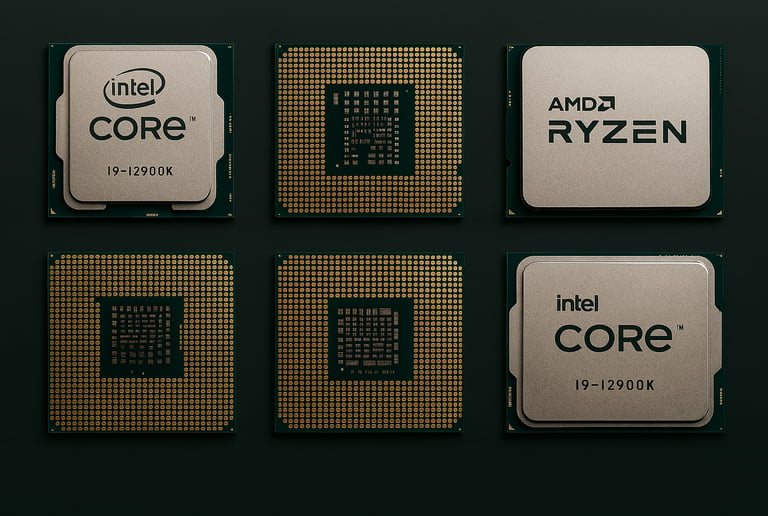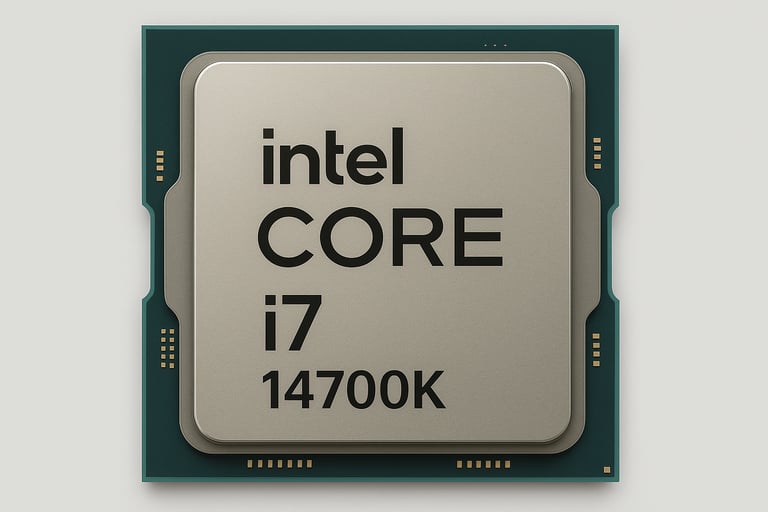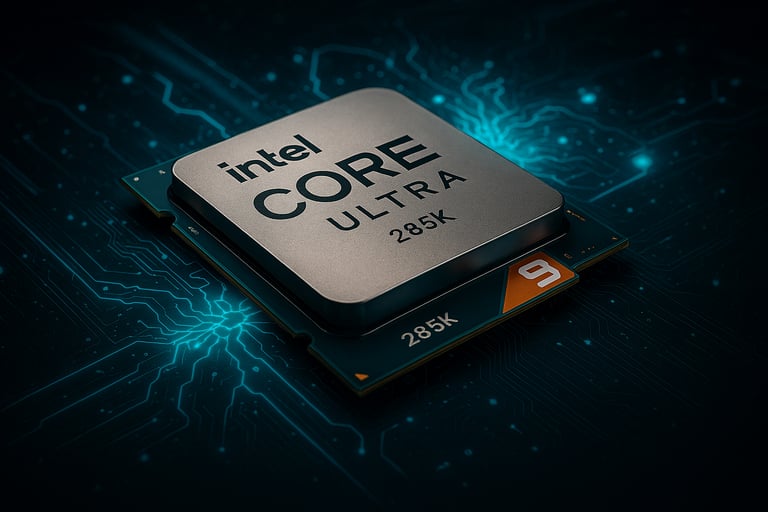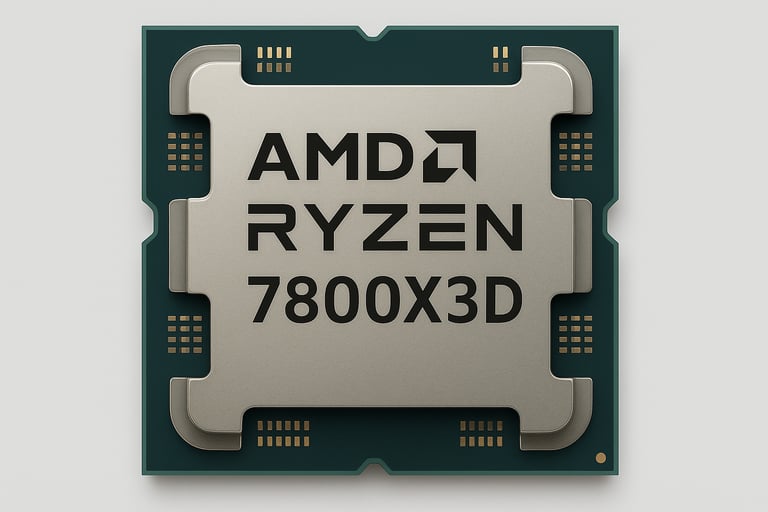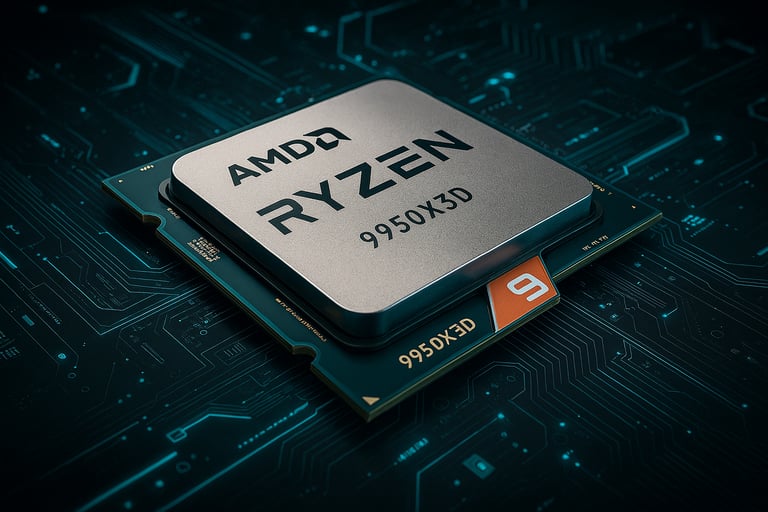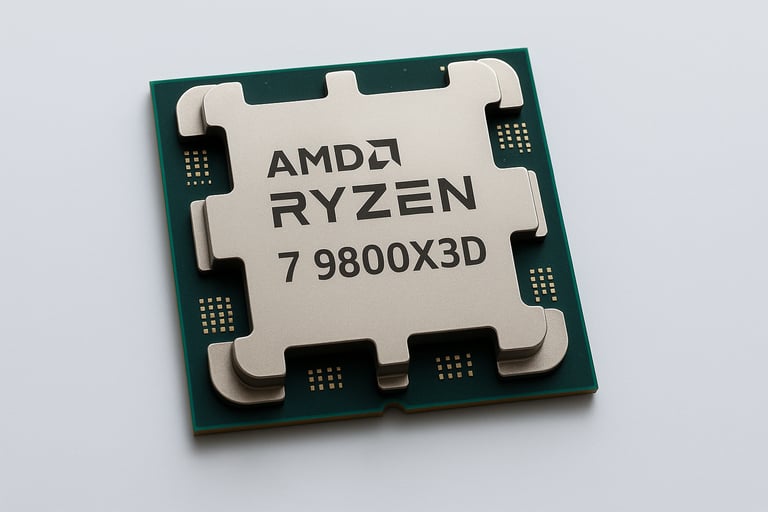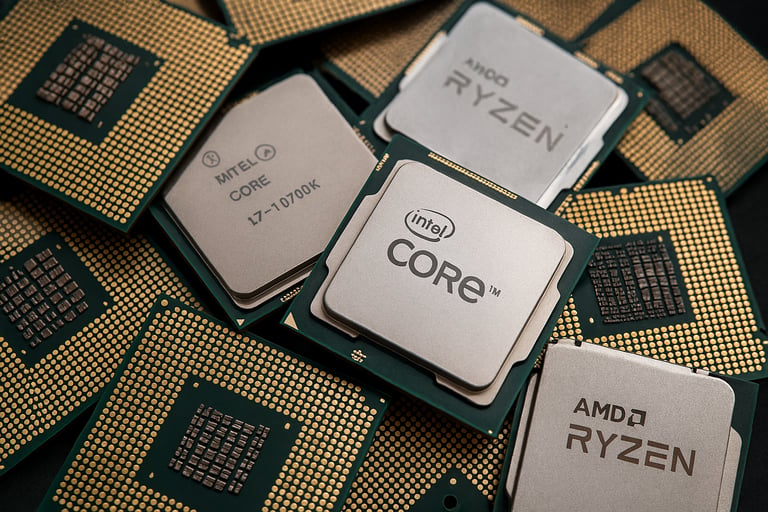Top 5 Best Gaming CPU's in 2025 — Ultimate Performance Guide
Discover the top 5 gaming CPU's in 2025, ranked by performance, cooling, and value. Compare AMD Ryzen 7 9800X3D, Intel Core i9-14900K, and more. Find your perfect processor for gaming and streaming this year.
10/15/202511 min read
The Top 5 Best PC CPU's in 2025: Expert Picks for Desktop Power, Performance, and Value
When you purchase through links on our site, we may earn an affiliate commission. Learn More
By Epic Loot Links Updated Oct 15, 2025 at 1:54 pm
Introduction: Navigating the 2025 Desktop CPU Landscape
The world of desktop computing is in the midst of another generational leap, where choosing the right CPU is more pivotal—and more complicated—than ever before. Whether you’re a gamer chasing the highest frame rates, a creative professional seeking fast render times, or an upgrader who wants the most value for the money, your choice of processor will dictate not just the speed but the very experience of your PC. The competition between AMD and Intel has driven a remarkable period of innovation, with both companies launching CPUs that push boundaries in performance, efficiency, and platform longevity. In 2025, architectural breakthroughs like second-generation 3D V-Cache, hybrid core designs, integrated AI engines, and advances in power efficiency are redefining what we expect from desktop processors.
This blog critically analyzes the five best desktop CPUs of 2025. Our selections reflect not just benchmark supremacy, but also real-world value and versatility. In line with best practices for professional human-like blog writing, we’ll break down each processor’s architecture, performance profile, key specifications, and unique strengths. We’ll also highlight their weaknesses—every processor has them—so you can make an informed choice tailored to your needs. Alongside in-depth descriptions, each CPU’s pros and cons are summarized, and we provide a comprehensive table for quick spec and value comparison. Looking for a GPu to match your CPu?
Criteria for Selecting the Best CPUs in 2025
Before revealing our top 5 picks, it’s essential to define the methodology and benchmarks informing our choices:
Performance: Both real-world and synthetic benchmarks, with an emphasis on single-core (for gaming, OS responsiveness) and multi-core (for content creation, productivity).
Power Efficiency: How effectively the chip delivers performance per watt, impacting heat, noise, and system requirements.
Value: Price-to-performance metrics considering U.S. retail pricing across the last quarter, and factoring in platform longevity.
Feature Set: Support for DDR5/DDR6, PCIe 5.0/6.0, and integrated graphics or AI/NPU engines.
Platform & Upgrade Path: AM5 for AMD and LGA1851 for Intel both enable forward-looking PC builds.
Up-to-Date Testing: Insights are drawn from freshly published reviews as of October 2025, including results with the latest RTX 5090 GPUs, fast DDR5 memory, and updated BIOS/firmware for peak compatibility.
1. AMD Ryzen 7 9800X3D: The Gaming King of 2025
Amazon.ca
The AMD Ryzen 7 9800X3D, launched in mid-2025, stands alone as the world’s fastest gaming processor. It’s built on AMD’s Zen 5 architecture, enhanced by second-generation 3D V-Cache stacking. This means a dense 96MB slab of L3 cache is layered right under the computing cores, drastically reducing gaming memory latency—critical for modern titles that demand fast on-chip data access. Clock speeds are aggressive, with a 4.7 GHz base and a 5.2 GHz boost, and the chip’s 120W TDP ensures sustained performance without demanding data-center cooling setups.
In real-world testing, the 9800X3D delivered stunning results: up to 35% better gaming performance than Intel’s latest Core Ultra 9 285K in popular games and an 8-15% improvement over AMD’s previous hero, the Ryzen 7 7800X3D. 1% and 0.1% lows—a critical measure for frame time smoothness—are exceptional, reducing stutter and latency spikes even in the most demanding esports, shooters, and open-world RPGs. Unlike the previous generation, AMD redesigned the V-Cache placement for superior thermal performance, so the 9800X3D stays below 75°C even under heavy gaming with an AIO cooler.
The processor’s efficiency deserves special note. In testing, the 9800X3D sipped less power than Intel’s competing chips, making it easier to cool and less expensive to run long-term. Its compatibility with any AM5 motherboard means a straightforward upgrade for existing AMD users—platform stability that’s rare in today’s fast-moving market.
Pros:
Outperforms all rivals in gaming—up to 35% ahead of the latest Intel flagship in benchmark suites.
Lower power consumption and cooler operating temperatures than competitors.
Superb 1% low frame rates ensure smooth gameplay—even at high graphics settings and competitive refresh rates.
Fully overclockable for enthusiasts who want to squeeze out extra performance.
AM5 platform support (including future CPU generations)—long upgrade path.
Cons:
Premium price for a mainstream chip; may be overkill for gamers not running high-refresh 1080p/1440p monitors.
No included cooler—requires a quality aftermarket solution for optimal temperatures.
Slightly behind the highest-end chips in multi-threaded content creation workloads.
2. AMD Ryzen 9 9950X3D: The Balanced Titan for Gaming & Creation
Amazon.ca*
The AMD Ryzen 9 9950X3D is a marvel of engineering that offers both no-compromise gaming and serious multi-threaded productivity. Featuring 16 cores and 32 threads on a Zen 5 foundation, and equipped with a massive 144MB of total cache—the most ever in a mainstream desktop gaming processor—the 9950X3D is a powerhouse for users who game, stream, and create. AMD’s second-generation 3D V-Cache technology ensures gaming frame rates close to the 9800X3D, while the high core count keeps render times, video editing, and AI workloads moving at record speed.
In multi-threaded productivity benchmarks (Cinema 4D, Blender, Premiere Pro), the 9950X3D rivals AMD’s own 9950X and overtakes Intel’s Core Ultra 9 285K in most content creation scenarios, while simultaneously maintaining top-tier gaming performance. Content creators who game on the side no longer need to make trade-offs—the 9950X3D does it all.
Thermal performance, long an Achilles’ heel of high-core-count CPUs, has been addressed by improved cache and die placement. However, all-core workloads can push temperatures towards the chip’s thermal limits, so premium cooling solutions—ideally 360mm AIOs or advanced air coolers—are recommended.
Pros:
Unmatched combination of gaming and professional workload speed.
16 cores/32 threads cover simultaneous streaming, gaming, 3D rendering, and AI tasks.
Massive cache improves both gaming and creation workloads—no need to compromise.
Future-proof AM5 platform and PCIe 5.0/DDR5 support.
Energy efficient for its performance class.
Fully overclockable and supports AVX-512 instructions for advanced applications.
Cons:
Pricey, sitting firmly in the high-end segment.
Requires strong cooling to avoid thermal throttling during long multi-core tasks.
Some software may not utilize all 16 cores efficiently.
3. AMD Ryzen 7 7800X3D: The Best Value Gaming CPU (Personal Favorite)
Amazon.ca
The AMD Ryzen 7 7800X3D remains a compelling value champion in 2025. Based on Zen 4 architecture and boasting 96MB of 3D V-Cache (similar cache configuration as the latest models), the 7800X3D delivers 95% of the 9800X3D’s gaming performance at a price point $120–$140 lower. For pure gaming, there’s no better balance of cost and real-world frame rates—especially if you game at 1080p or 1440p. Reviewers consistently note frame rate averages exceeding 140 FPS in modern AAA titles, with 1% lows above 120 FPS—keeping gameplay buttery smooth in the most graphically intense scenarios.
Thermals and power draw are also improved over prior X3D generations, rarely exceeding 75–80°C with sufficient cooling and averaging around 90W in extended gaming sessions—less than many Intel chips in this price tier. While the 7800X3D trails higher-end CPUs in multi-core productivity tasks, it still offers competent performance for moderate creative work and everyday multitasking.
Pros:
Exceptional price-to-performance ratio: nearly top-tier gaming FPS for mid-tier pricing.
Efficient power usage and low running temperatures.
Compatible with AM5 platform—future upgrade flexibility.
Runs on basic air coolers (with some caveats for sustained or overclocked use).
Cons:
Lower multi-core/threaded performance compared to 9950X3D or Core Ultra 9 285K.
No included cooler.
Runs hot at maximum load with insufficient cooling (89°C reported with small AIOs).
Overkill for casual 60Hz gaming.
4. Intel Core Ultra 9 285K: Intel’s Arrow Lake Flagship
Amazon.ca
Intel’s Core Ultra 9 285K, launched in late 2024 as Arrow Lake’s desktop flagship, marks a turning point for Intel’s desktop lineup. Sporting 24 cores (8 performance + 16 efficient) and up to 5.7 GHz turbo speeds, this CPU is an AI-accelerated, hybrid monster. The integration of a dedicated AI NPU, improved Intel Xe graphics, and support for up to DDR5-6400 memory mark this as an elite platform for power users, creators, and prosumers who want the best of Intel’s latest technology.
Productivity workloads are where the 285K truly shines. In video encoding, 3D rendering, and scientific modeling, it matches or slightly trails the Ryzen 9 9950X—a monumental feat given the AMD chip’s higher thread count. Multitasking is a strong suit; background processes and heavy software rarely dent the responsiveness or snappiness of the system. The chip’s AI and NPU capabilities future-proof it for emerging workloads, especially as AI integration proliferates in creative and professional apps.
However, in gaming benchmarks, the 285K sometimes lags behind AMD’s 3D V-Cache chips by 15–25%—particularly in highly cache-dependent titles. Nevertheless, it remains competitive in many games, and its single-threaded performance actually leads in certain benchmarks, making it a flexible choice for gamers who also need high-end productivity.
Thermal demands are moderate for a flagship, with a 125W TDP, but peak loads can push it beyond 200W; robust cooling and a high-end motherboard are recommended for stability and best performance.
Pros:
Class-leading multi-core performance for content creation, streaming, and AI workloads.
Dedicated AI NPU—future-proofs platform for AI-driven applications.
Strong single-thread performance, competitive in gaming versus prior-gen Intel CPUs.
Improved power efficiency and thermals compared to last-gen Intel flagships.
Platform supports PCIe 5.0, DDR5, and Intel Xe graphics for integrated GPU solutions.
Cons:
Gaming performance trails AMD’s cache-enhanced chips at similar price points.
High price for top-end model.
No included cooler; aftermarket solution required.
Requires the latest LGA1851 platform—no backward compatibility.
5. Intel Core i7-14700K: The Performance-Value Sweet Spot
Amazon.ca
The Intel Core i7-14700K represents outstanding value for high-end gaming and productivity without the flagship price tag. With 20 total cores (8 performance + 12 efficient), 28 threads, and a turbo boost up to 5.6 GHz, the 14700K delivers essentially the same gaming performance as Intel’s top-of-the-line Core i9-14900K, while costing far less. This chip is a mainstay in enthusiast PCs and is often recommended as the “best buy” for high-FPS gaming, streaming, and demanding everyday multitasking.
Benchmarks reveal gaming numbers within 5% of the flagship 14900K and AMD's non-3D V-Cache competitors. In simultaneous streaming, video editing, or compiling, its hybrid design also allows background tasks to continue without impacting frame rates or system responsiveness. Compatibility with DDR4 or DDR5 memory and broad motherboard support ensures both performance and budget flexibility—making it a great fit for upgraders and new builders alike.
Thermally, expect it to run hot under heavy load; a quality air or liquid cooler is essential for unlocking its best performance, especially during long rendering or streaming sessions.
Pros:
Exceptional performance for the price—nearly flagship gaming/creation output at a lower cost.
Flexible platform support; works with existing DDR4 or newer DDR5 systems.
Integrated graphics for troubleshooting or builds without a GPU.
Great for “do-it-all” PCs—gaming, streaming, creation, and multitasking.
Cons:
High power draw and heat under load (upper 200W+ possible).
No included cooler.
Lags AMD 3D V-Cache processors in a few gaming benchmarks at CPU-bound settings.
Honorable Mentions and Trends Outside the “Top 5”
While the above five CPUs dominate the conversation in 2025, there are several honorable mentions and trends worth considering for those with highly specialized needs or tighter budgets:
AMD Ryzen 5 9600X: Sporting the new Zen 5 architecture and a 5.4GHz boost at a $192 price point, the 9600X is a budget gaming standout—delivering surprisingly high FPS and robust performance for entry-level and mid-range builders.
Apple M3 Ultra (Desktop): The M3 Ultra's 32-core CPU, unified memory up to 512GB, and 80-core GPU make it industry-leading for Mac-based AI, creative, and scientific workflows—but it's a niche choice reserved for those locked into the Apple ecosystem.
AMD Ryzen 7 9700X: Offering excellent performance-per-watt and thermal efficiency, this chip excels in small form factor (SFF) and passively cooled builds.
Qualcomm Snapdragon X Series: Not yet a mainstream Windows desktop competitor, but notable for small-form-factor, always-on devices in business and productivity contexts.
Benchmarks and Real-World Testing: The Critical Perspective
In 2025, benchmarks are more nuanced than ever. According to aggregated results from Tom’s Hardware, PassMark, and hands-on reviews, the days when just clock speed or raw core count determined performance are gone. For gaming, single-core and cache efficiency dominate up to 1440p, while multi-core scaling becomes vital for video editing, 3D rendering, and data analysis.
The AMD 3D V-Cache advantage is real: The 9800X3D consistently holds the top spots in gaming FPS and minimizes “1% low” frame dips for a smoother experience—crucial for esports and VR.
Intel’s Arrow Lake (Ultra 9 285K) boasts leadership in single-threaded benchmarks on platforms like PassMark and Cinebench, translating to excellent desktop responsiveness and strong productivity results.
Energy Efficiency: AMD’s Zen 5 and Zen 4 chips generally consume less power for similar or greater performance than Intel, translating to quieter, cooler, and potentially longer-lived systems.
It's important for readers to evaluate benchmark sources and check for the games, workloads, and system configurations most similar to their planned use case. New GPU generations and BIOS updates can further shift the pecking order between AMD and Intel—so always consult recent data.
AMD vs. Intel: The Competitive Landscape
2025 is a banner year for competition. AMD maintains a clear lead in gaming thanks to its 3D V-Cache technology, with chips like the Ryzen 7 9800X3D and 9950X3D staking out the top spots for gaming-centric builds. Intel, meanwhile, holds its ground in productivity with the Core Ultra 9 285K and offers fantastic all-rounders like the Core i7-14700K.
Both major manufacturers offer future-proof platforms—AM5 and LGA1851/Q, with extended chipset support, PCIe 5.0 or 6.0, and high memory bandwidth (DDR5/DDR6). Buyers should also weigh customer support, software optimizations (such as AI engine integration), and update cadence for BIOS and drivers.
Tech and Market Trends Shaping 2025 CPUs
Several industry-wide trends shape the current top CPU landscape:
AI and NPUs: Integrated AI engines (NPUs) are now standard on many high-end CPUs, enabling local AI workloads, smarter background process management, and future accelerations as software support matures.
3D Stacked Cache: AMD’s second-generation implementations continue to redefine what’s possible for gaming and minimize system bottlenecks in CPU-bound scenarios.
Hybrid Core Designs: Intel’s big.LITTLE (performance and efficiency) approach powers multitasking and background processing, leading to higher real-world throughput in parallel workflows.
Platform Longevity: Both AMD’s AM5 and Intel’s LGA1851/LGA1700 platforms offer several generations of upgrade headroom, cushioning buyers against the fast pace of tech obsolescence.
Choosing the Right CPU in 2025: Practical Recommendations
Ultimately, the “best” CPU is the one that’s right for your workflow and your budget. Some guidance emerges from our testing and analysis:
Pure Gaming at Any Cost: Get the AMD Ryzen 7 9800X3D. Its out-of-the-box performance, cache-driven latency reduction, and efficiency create the smoothest gaming possible.
Gaming plus Content Creation: The AMD Ryzen 9 9950X3D is your best friend if you run Premiere Pro, Blender, or stream while multitasking.
Best Value: Don’t overlook the AMD Ryzen 7 7800X3D. It offers close to flagship gaming at a much lower price—making it the smart buy for dedicated gaming rigs.
Enthusiast or Professional Workstation: Choose the Intel Core Ultra 9 285K for maximum productivity, or the AMD Ryzen 9 9950X for pure creation without the gaming cache premium.
All-Rounder / Budget High-End: The Intel Core i7-14700K delivers near-flagship performance—both gaming and productivity—while leaving budget for a better GPU, SSD, or display.
conclusion: The 2025 CPU Market—Buy What You Need, Upgrade Smart
The desktop CPU market in 2025 offers more performance, efficiency, and choice than ever before. AMD and Intel, through fierce competition and architectural innovation, ensure high-value options at every segment of the market—whether you’re a frame-rate-obsessed gamer, a multitasking professional, or a value-conscious upgrader.
Think carefully about your computing needs and pick a processor that fits them. Don’t fall into the trap of buying the top-tier, most expensive chip “just because”—even mid-range CPUs now rival the previous generation’s best in both gaming and productivity. Instead, invest in a platform with room to grow, pair your CPU with compatible RAM, SSD, and cooling, and enjoy a system that will stand the test of time.
As we look ahead, consider that technology’s rapid improvement cycle means today’s midrange CPUs might match tomorrow’s flagships. Rather than overbuying, plan for more frequent and incremental upgrades, keeping your build responsive to advances in gaming, creator, and AI workloads.
May your frames be high, your renders fast, your upgrades smooth, and your PC journey truly next-gen.
